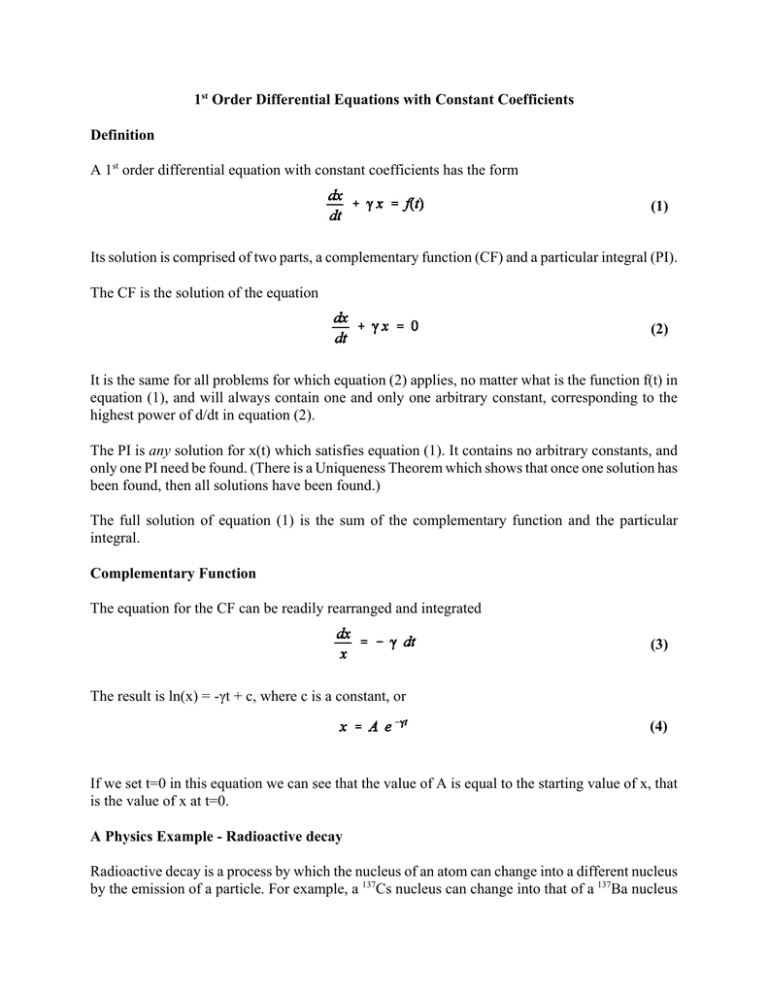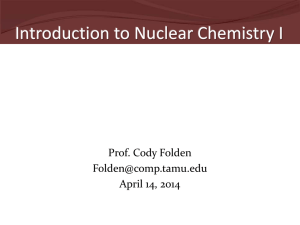First order equations with constant coefficients
advertisement

1st Order Differential Equations with Constant Coefficients Definition A 1st order differential equation with constant coefficients has the form (1) Its solution is comprised of two parts, a complementary function (CF) and a particular integral (PI). The CF is the solution of the equation (2) It is the same for all problems for which equation (2) applies, no matter what is the function f(t) in equation (1), and will always contain one and only one arbitrary constant, corresponding to the highest power of d/dt in equation (2). The PI is any solution for x(t) which satisfies equation (1). It contains no arbitrary constants, and only one PI need be found. (There is a Uniqueness Theorem which shows that once one solution has been found, then all solutions have been found.) The full solution of equation (1) is the sum of the complementary function and the particular integral. Complementary Function The equation for the CF can be readily rearranged and integrated (3) The result is ln(x) = -γt + c, where c is a constant, or (4) If we set t=0 in this equation we can see that the value of A is equal to the starting value of x, that is the value of x at t=0. A Physics Example - Radioactive decay Radioactive decay is a process by which the nucleus of an atom can change into a different nucleus by the emission of a particle. For example, a 137Cs nucleus can change into that of a 137Ba nucleus by the emission of an electron 137 Cs 6 137Ba + e- a process known as β decay. The rate at which Cs nuclei are lost by conversion to Ba nuclei depends on the number of Cs nuclei remaining in the same, that is we can write (5) This is the same as equation (2), and we can write N = Ae-γt as the solution of this equation. The decay constant γ is usually expressed in terms of a quantity known as the half life (τ½), which is the time it takes for the number of nuclei remaining to be reduced by ½. If we write N = ½A = Ae-γτ and solve we can see that γ = ln2/τ½. Given that the half life of 137Cs is equal to 30 years, how much of a 137Cs sample will remain after 12 years? Using time units in years, γ = ln2/30 = 0.0231. We can determine that the remaining number of nuclei after 12 years is N = Ae-(0.0231)(12) = 0.758A. We therefore have 75.8% of the original sample remaining. A 2nd Physics Example - RC decay A capacitor C is initially charged to a voltage of Vo. At t=0 a resistor R is connected in parallel to the capacitor. What is the current through the resistor as a function of time? Elements in parallel have the same voltage and so we can write VR = VC, or iR = q/C. The rate at which charge flows through the resistor is also the rate at which charge leaves the capacitor, and so we can also write i = -dq/dt. Combining these equations we get The solution of this equation is i = Ae-t/RC. The product τ=RC is called the time constant of the combination, in which case i = Ae-t/τ. Since the voltage across the resistor R is equal to Vo at t=0 it also follows that A = Vo/R. The final expression for the current is i = (Vo/R)e-t/RC = (Vo/R)e-t/τ. If we set C=50 nF, R=2.2 kΩ, and Vo=15 V C C C The initial current through the resistor is 15/2.2 = 6.82 mA. The time constant is equal to τ=RC=(2.2 kΩ)(50 nF) = 0.11 ms. When t=0.2 ms the current has fallen to 6.82e-0.2/0.11 = 1.11 mA. Particular Integral The particular integral which corresponds to equation (1) depends on the function f(t), usually known as the driving function. In principle any function can be used, but a common possibility is a sinusoidal function Acos(ωt), although in this case it is easier to use the equivalent complex representation Aeiωt, remembering that we only need the real part of this function. Since the driving function f(t) is sinusoidal it is reasonable to assume that the particular integral will also be sinusoidal. If we assume x=xoeiωt, then equation (1) becomes (7) from which (8) where tanφ=ω/γ. The final expression for x is (9) A Physical Example - RC Circuit A 1000 Hz (ω=2πf=2000π) voltage with an amplitude of 60 V is applied to a series combination of a 50 nF capacitor and a 2.2 kΩ resistor. What is the current through the resistor? Now that the capacitor and resistor are in series they have the same current, and the sum of their voltages is equal to the applied voltage (10) (j=/-1, since i is used to represent the current.) Differentiating once we get (11) If we substitute a particular integral of the form i = Aejωt into equation (11) then (12) The solution for the current is therefore (13) A Physical Example - Double Decay When one radioactive nucleus decays it produces a new nucleus, which itself might also be radioactive. For example, 224Ra decays to 220Rn by the emission of an alpha particle, and 220Rn will decay by the emission of a second alpha particle to produce 216Po. Suppose that we have a large number of nuclei of isotope A, which decays with a decay constant γa to create nucleus B. Let nucleus B decay with a decay constant γb to produce nucleus C. Let the original number of A nuclei be No, and the original number of B nuclei be zero. The problem is to find the number of B nuclei as a function of time. As time progresses the number of B nuclei increases from the radioactive decay of the A nuclei, and decreases from the radioactive decay of the B nuclei. As a rate equation we can write (14) From the earlier section on radioactive decay, the number of nuclei of isotope A as a function of time is Na = Noe-γat. Equation (13) can then be written as (15) This equation has the complementary function Ae-γbt, where A is a constant to be found from the initial conditions. To find the particular integral, note that f(t) varies as e-γat, and so it is reasonable to assume that the particular integral will do so also. We will therefore assume a particular integral of the form Nb=Be-γat. Substituting into equation (14) and rearranging gives We can therefore write the solution to equation (14) as the sum of the complementary function and the particular integral If we now add the condition that Nb=0 when t=0 we can solve for A, and then write the final result as




